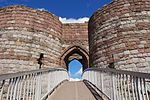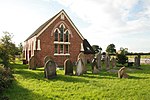Brassey Green

Brassey Green is a small rural village near Tarporley, in Tiverton and Tilstone Fearnall civil parish, within the unitary authority of Cheshire West and Chester and the ceremonial county of Cheshire, England. Brassey Green Hall is a two storeyed, 16th century farmhouse and a designated Grade II listed building. It is timber-framed with wattle and daub and rendered brick infill and a slate roof. The 18th century Brassey Green Baptist Chapel is also Grade II listed. Constructed with red brick and a Welsh slate roof, it was restored from 1983 after falling into disrepair. Although no longer a place of worship, it has since been used occasionally by youth groups.
Excerpt from the Wikipedia article Brassey Green (License: CC BY-SA 3.0, Authors, Images).Brassey Green
Huxley Lane,
Geographical coordinates (GPS) Address Nearby Places Show on map
Geographical coordinates (GPS)
| Latitude | Longitude |
|---|---|
| N 53.141 ° | E -2.703 ° |
Address
Huxley Lane
Huxley Lane
CW6 9UG , Tiverton and Tilstone Fearnall
England, United Kingdom
Open on Google Maps











